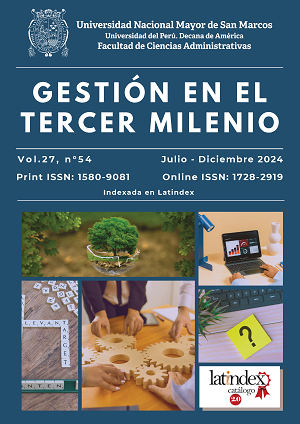Correlational analysis of internal marketing and internal customer loyalty as strategies for increasing competitiveness and productivity
DOI:
https://doi.org/10.15381/gtm.v27i54.28058Keywords:
internal marketing, internal customer loyalty, internal communication, workforce development, organizational supportAbstract
The main objective of this study was to determine the relationship between internal marketing and internal customer loyalty in a printing company located in Lima, Peru. The method used was a quantitative approach with an applied research design, at a correlational and non-experimental level. A survey was used by means of a 70-item questionnaire distributed to 106 employees selected by simple random sampling. The nonparametric correlation coefficient Spearman's Rho was used to measure the strength of the association between the variables. The reliability of this measuring instrument was evaluated by means of the Cronbach's alpha coefficient, which yielded a value of 0.972, indicating a high reliability and cohesion between the questions of the questionnaire. The results obtained show that there is a correlation between internal marketing (0.719) and internal marketing dimensions such as motivation, which obtained the highest score (0.706), followed by work development (0.668), organizational support (0.601) and internal communication (0.577) with the variable internal customer loyalty. The study concludes that systematic improvement of the organizational structure and internal communication programs, as well as constant motivation of the workforce at all hierarchical levels, are the key elements of internal marketing to promote a shared vision among employees to ensure competitive development and productivity.
Downloads
Published
Issue
Section
License
Copyright (c) 2024 Eddy Hugo Arias Borda

This work is licensed under a Creative Commons Attribution 4.0 International License.
THE AUTHORS RETAIN THEIR RIGHTS:
(a) The authors retain their trademark and patent rights, and also over any process or procedure described in the article.
(b) The authors retain the right to share, copy, distribute, execute and publicly communicate the article published in Gestión en el Tercer Milenio journal (for example, place it in an institutional repository or publish it in a book), with acknowledgment of its initial publication in the Gestión en el Tercer Milenio.
(c) Authors retain the right to make a subsequent publication of their work, to use the article or any part of it (for example: a compilation of their work, lecture notes, thesis, or for a book), provided that they indicate the source. of publication (authors of the work, magazine, volume, number and date).






